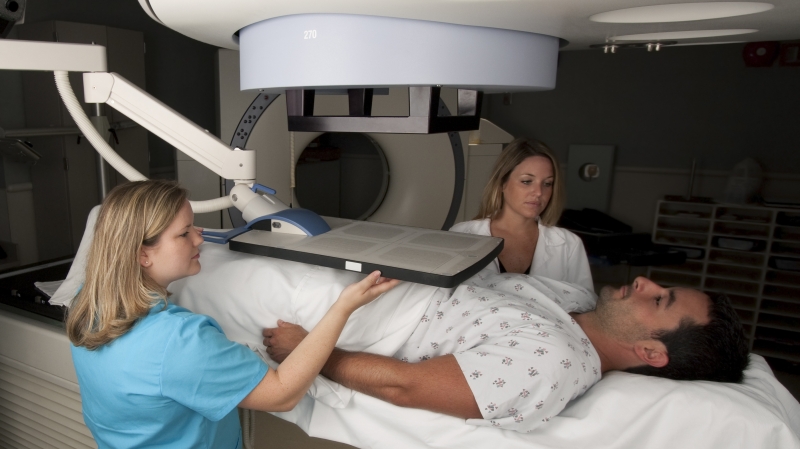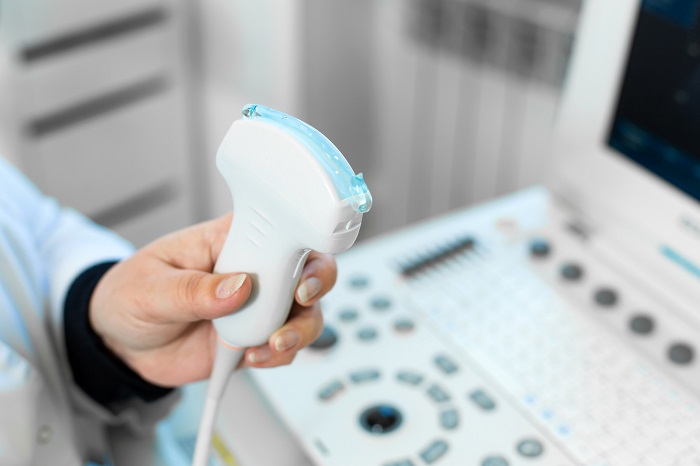New Detection Method Spares Unnecessary Prostate Cancer Treatments
|
By MedImaging International staff writers Posted on 18 Apr 2016 |

Scanning for prostate cancer for 3D modeling (Photo courtesy of St. George\'s University of London).
A novel three-dimensional (3D) cell model that mimics the morphogenesis of acini, the glandular units that constitute the prostate, could help study how prostate cancer (PC) progresses.
Developed by researchers at St. George's University of London, the 3D cellular model monitors the morphogenesis of the glandular structures using microscopy and imaging techniques, which can help identify the intraluminal hyperproliferation of the acini. By identifying the factors that alter the epithelial organization of acini that lead to the intraluminal proliferation, the researchers hope to develop a strategy that can help determine the causes of PC progression.
Using the 3D acini model, the researchers are developing methods that will provide objective measures for patient stratification and disease grading, which could thus complement current clinical classification of patients diagnosed with PC. By doing so, they hope to be able to consistently distinguish aggressive PC from indolent disease, a distinction currently difficult to identify, which often leads to inappropriate treatment and high morbidity and mortality.
“Based on these cell culture models, we believe a test could be developed to assess how invasive a prostate cell could become when taken from a patient,” said principal investigator Ferran Valderrama, PhD, of the SGUL PC cell biology laboratory. “We believe that this information would help to determine the appropriate treatment for the patient, reducing the burden derived from unnecessary over treatment, and overall having a positive outcome in patient survival.”
“The currently available prognostic tests for prostate cancer cannot conclusively tell us whether a tumor will rapidly progress and spread to other tissues, or instead will remain confined to the limits of the prostate,” added Dr. Ferran Valderrama. “Improving current procedures for predicting the outcome of a prostate that presents with ‘suspicious’ characteristics of prostate cancer are necessary. If we were able to determine that outcome in a consistent and conclusive manner, it would be easier to define the best approach for treatment for each individual case.”
Related Links:
St George's University of London
Developed by researchers at St. George's University of London, the 3D cellular model monitors the morphogenesis of the glandular structures using microscopy and imaging techniques, which can help identify the intraluminal hyperproliferation of the acini. By identifying the factors that alter the epithelial organization of acini that lead to the intraluminal proliferation, the researchers hope to develop a strategy that can help determine the causes of PC progression.
Using the 3D acini model, the researchers are developing methods that will provide objective measures for patient stratification and disease grading, which could thus complement current clinical classification of patients diagnosed with PC. By doing so, they hope to be able to consistently distinguish aggressive PC from indolent disease, a distinction currently difficult to identify, which often leads to inappropriate treatment and high morbidity and mortality.
“Based on these cell culture models, we believe a test could be developed to assess how invasive a prostate cell could become when taken from a patient,” said principal investigator Ferran Valderrama, PhD, of the SGUL PC cell biology laboratory. “We believe that this information would help to determine the appropriate treatment for the patient, reducing the burden derived from unnecessary over treatment, and overall having a positive outcome in patient survival.”
“The currently available prognostic tests for prostate cancer cannot conclusively tell us whether a tumor will rapidly progress and spread to other tissues, or instead will remain confined to the limits of the prostate,” added Dr. Ferran Valderrama. “Improving current procedures for predicting the outcome of a prostate that presents with ‘suspicious’ characteristics of prostate cancer are necessary. If we were able to determine that outcome in a consistent and conclusive manner, it would be easier to define the best approach for treatment for each individual case.”
Related Links:
St George's University of London
Latest General/Advanced Imaging News
- Bone Density Test Uses Existing CT Images to Predict Fractures
- AI Predicts Cardiac Risk and Mortality from Routine Chest CT Scans
- Radiation Therapy Computed Tomography Solution Boosts Imaging Accuracy
- PET Scans Reveal Hidden Inflammation in Multiple Sclerosis Patients
- Artificial Intelligence Evaluates Cardiovascular Risk from CT Scans
- New AI Method Captures Uncertainty in Medical Images
- CT Coronary Angiography Reduces Need for Invasive Tests to Diagnose Coronary Artery Disease
- Novel Blood Test Could Reduce Need for PET Imaging of Patients with Alzheimer’s
- CT-Based Deep Learning Algorithm Accurately Differentiates Benign From Malignant Vertebral Fractures
- Minimally Invasive Procedure Could Help Patients Avoid Thyroid Surgery
- Self-Driving Mobile C-Arm Reduces Imaging Time during Surgery
- AR Application Turns Medical Scans Into Holograms for Assistance in Surgical Planning
- Imaging Technology Provides Ground-Breaking New Approach for Diagnosing and Treating Bowel Cancer
- CT Coronary Calcium Scoring Predicts Heart Attacks and Strokes
- AI Model Detects 90% of Lymphatic Cancer Cases from PET and CT Images
- Breakthrough Technology Revolutionizes Breast Imaging
Channels
Radiography
view channel
Novel Breast Imaging System Proves As Effective As Mammography
Breast cancer remains the most frequently diagnosed cancer among women. It is projected that one in eight women will be diagnosed with breast cancer during her lifetime, and one in 42 women who turn 50... Read more
AI Assistance Improves Breast-Cancer Screening by Reducing False Positives
Radiologists typically detect one case of cancer for every 200 mammograms reviewed. However, these evaluations often result in false positives, leading to unnecessary patient recalls for additional testing,... Read moreMRI
view channel
Low-Cost Whole-Body MRI Device Combined with AI Generates High-Quality Results
Magnetic Resonance Imaging (MRI) has significantly transformed healthcare, providing a noninvasive, radiation-free method for detailed imaging. It is especially promising for the future of medical diagnosis... Read more
World's First Whole-Body Ultra-High Field MRI Officially Comes To Market
The world's first whole-body ultra-high field (UHF) MRI has officially come to market, marking a remarkable advancement in diagnostic radiology. United Imaging (Shanghai, China) has secured clearance from the U.... Read moreUltrasound
view channel
Portable Ultrasound Tool Uses AI to Detect Arm Fractures More Quickly
Suspected injuries to the upper limbs are a major reason for visits to hospital emergency departments. Currently, wait times for an X-ray and subsequent doctor consultation can vary widely, typically ranging... Read more.jpg)
Diagnostic System Automatically Analyzes TTE Images to Identify Congenital Heart Disease
Congenital heart disease (CHD) is one of the most prevalent congenital anomalies worldwide, presenting substantial health and financial challenges for affected patients. Early detection and treatment of... Read more
Super-Resolution Imaging Technique Could Improve Evaluation of Cardiac Conditions
The heart depends on efficient blood circulation to pump blood throughout the body, delivering oxygen to tissues and removing carbon dioxide and waste. Yet, when heart vessels are damaged, it can disrupt... Read more
First AI-Powered POC Ultrasound Diagnostic Solution Helps Prioritize Cases Based On Severity
Ultrasound scans are essential for identifying and diagnosing various medical conditions, but often, patients must wait weeks or months for results due to a shortage of qualified medical professionals... Read moreNuclear Medicine
view channel
New PET Biomarker Predicts Success of Immune Checkpoint Blockade Therapy
Immunotherapies, such as immune checkpoint blockade (ICB), have shown promising clinical results in treating melanoma, non-small cell lung cancer, and other tumor types. However, the effectiveness of these... Read moreNew PET Agent Rapidly and Accurately Visualizes Lesions in Clear Cell Renal Cell Carcinoma Patients
Clear cell renal cell cancer (ccRCC) represents 70-80% of renal cell carcinoma cases. While localized disease can be effectively treated with surgery and ablative therapies, one-third of patients either... Read more
New Imaging Technique Monitors Inflammation Disorders without Radiation Exposure
Imaging inflammation using traditional radiological techniques presents significant challenges, including radiation exposure, poor image quality, high costs, and invasive procedures. Now, new contrast... Read more
New SPECT/CT Technique Could Change Imaging Practices and Increase Patient Access
The development of lead-212 (212Pb)-PSMA–based targeted alpha therapy (TAT) is garnering significant interest in treating patients with metastatic castration-resistant prostate cancer. The imaging of 212Pb,... Read moreImaging IT
view channel
New Google Cloud Medical Imaging Suite Makes Imaging Healthcare Data More Accessible
Medical imaging is a critical tool used to diagnose patients, and there are billions of medical images scanned globally each year. Imaging data accounts for about 90% of all healthcare data1 and, until... Read more
Global AI in Medical Diagnostics Market to Be Driven by Demand for Image Recognition in Radiology
The global artificial intelligence (AI) in medical diagnostics market is expanding with early disease detection being one of its key applications and image recognition becoming a compelling consumer proposition... Read moreIndustry News
view channel
Hologic Acquires UK-Based Breast Surgical Guidance Company Endomagnetics Ltd.
Hologic, Inc. (Marlborough, MA, USA) has entered into a definitive agreement to acquire Endomagnetics Ltd. (Cambridge, UK), a privately held developer of breast cancer surgery technologies, for approximately... Read more
Bayer and Google Partner on New AI Product for Radiologists
Medical imaging data comprises around 90% of all healthcare data, and it is a highly complex and rich clinical data modality and serves as a vital tool for diagnosing patients. Each year, billions of medical... Read more


















